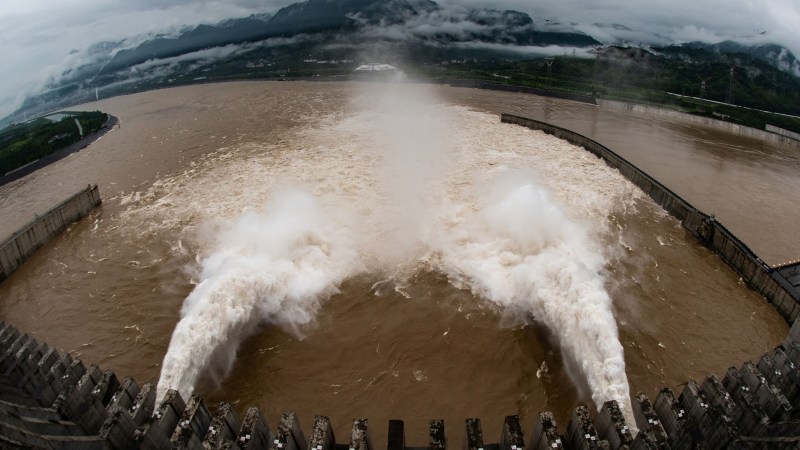
China has been suffering through record rains the past weeks, leading to the worst flooding in the country in decades. There is little relief in sight, and the Yangtze River is now above flood level, according to China’s Ministry of Water Resources. A few days ago, officials admitted that certain “peripheral” structures of the massive Three Gorges Dam deformed due to the building water pressure. Stunning pictures of water being released to relieve pressure are raising the specter of whether the entire dam could fail (some good photos here). Some online satellite photos purporting to show the buckling of the dam, however, should be viewed with skepticism.
Still, the damage that has already occurred from the record deluge is significant, with numerous cities upriver from the dam already flooded. According to the Wall Street Journal:
Some 40 million people in more than two dozen provinces have been affected by the flooding as of July 12, causing more than 80 billion yuan ($11.5 billion) of direct damage to the economy, according to China’s Ministry of Emergency Management. Around 28,000 homes have collapsed, while millions have been displaced and at least 141 people have been declared dead or missing in the floods.
All that would be dwarfed if the Three Gorges Dam failed. The dam was built from 1994 to 2006, at a cost of $31 billion and displacing 1.4 million people for its construction, precisely to lessen the risk of devastating flooding along the Yangtze, a perennial problem in China since ancient times. The river’s basin accounts for nearly half of China’s agricultural output, and it runs through major cities, such as Wuhan, with 10 million people.
Chinese authorities have already evacuated 38 million people downriver. The dam can hold back waters to a level of 175 meters above sea level; according to the Bureau of Hydrology of the Chanjiang (Yangtze) Water Resources Commission, the latest (Friday) height at the dam was 158.85 meters, down from 164 meters on Tuesday. Yet more rain is predicted, and if smaller, older dams upriver from Three Gorges overflow or fail, then the pressure on the main dam could quickly overwhelm either its capacity or even its structural integrity.
While an outright failure of the dam may not be the primary danger, nonetheless its geopolitical consequences are staggering to contemplate. It would be a black swan of epic proportions, China’s Chernobyl moment. A tsunami-like wave from a breach in the Three Gorges Dam could wipe out millions of acres of farmland right before the autumn harvest, possibly leading to famine-like conditions. As it is also the world’s largest hydroelectric power station, a failure would lead to huge power outages. Low-lying cities of millions along the Yangtze’s banks cities could become uninhabitable and the death toll could be staggering.
China’s heartland manufacturing and inland shipping along the Yangtze, which empties out into the East China Sea at Shanghai, would be significantly affected by downriver flooding, potentially leading to major economic disruption inside China and around the world. The political impact could be enough to destabilize the Chinese Communist Party (CCP), in the same way that Chernobyl was the nail in the coffin of the Soviet Communist Party. Public anger, already stoked by the draconian state response to the coronavirus pandemic that started in Wuhan, could boil over, even if many understand that the rains are an act of nature.
Given the social and political implications of the current flooding, and the specter of a Three Gorges breach, it may not be a complete coincidence that Beijing last week announced its second-largest purchase of U.S. corn ever, to the tune of 1.365 million tons, along with 320,000 tons of winter and spring wheat. From a political perspective, the dam’s failure would be the gravest crisis faced by CCP general secretary Xi Jinping, comparable to the Katrina hurricane that so tarnished George W. Bush’s reputation. Unlike the weakened post-Chernobyl USSR, however, a destabilized CCP could well become a more dangerous one, looking to divert public anger towards “enemies” such as Taiwan, Japan, and the United States.
That Xi has not visited the dam or seemingly made it a public priority may mean that he’s been assured by Chinese engineers and hydrologists that the dam can withstand the current deluge. A long-overdue rebalancing in U.S.–China relations is taking place, and a hard-edged policy of reciprocity is entirely proper in dealing with Beijing’s endemic predatory and abusive behavior. However, for humanitarian, economic, and geopolitical reasons, the world should obviously hope the Three Gorges Dam holds. 2020 has already been enough of an annus terribilis.




